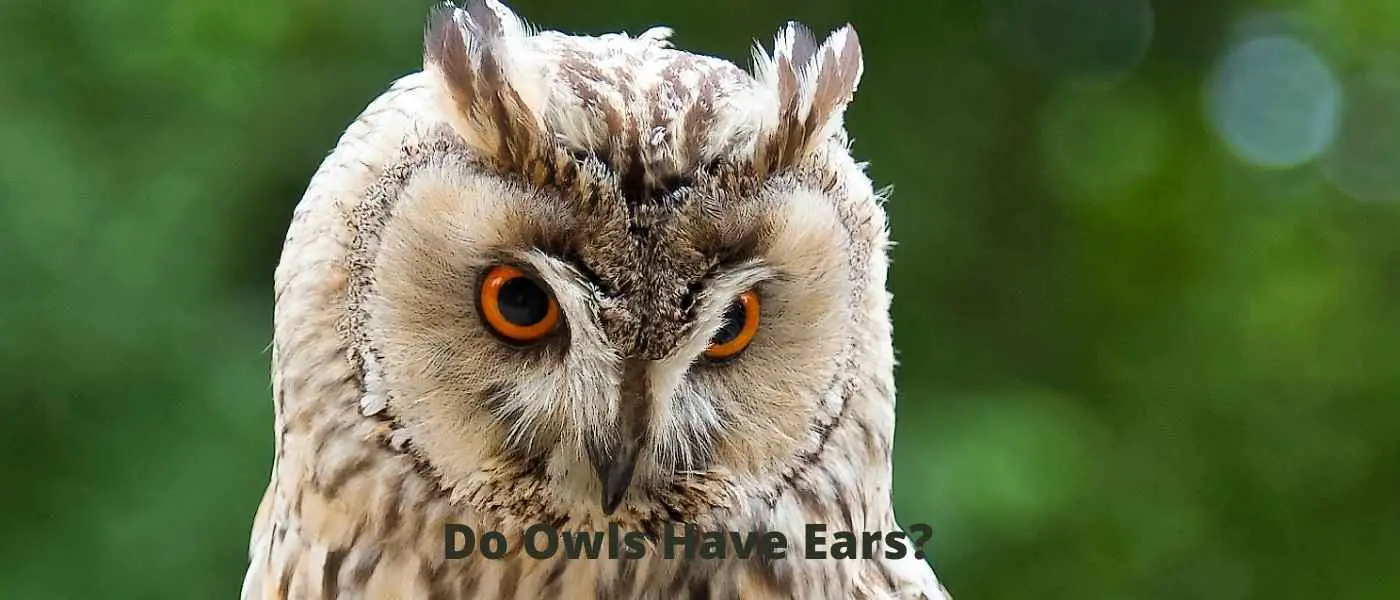One of the most distinctive features of owls is their eyes, which are large and round, giving them excellent night vision. But did you know that owls also have very good hearing?
In fact, their sense of hearing is so acute that they can hunt even in complete darkness. So, yes owls have ears but they are not easy to see. They are hidden in the feathers around the owl’s face.
The feathers on the owl’s face help direct sounds towards the ears. This gives owls the ability to locate prey with pinpoint accuracy. This is also the reason why owl faces are flatter than other birds species.
Do Owls Have Ears Made of Feathers?
While owls certainly have offset ears, they are not exactly where you would expect them to be. Most owls have feather ear tufts, which are pretty standard. And these tufts are simply display feathers rather than actual ears.
Eastern screech owls and other species of owls have small ear tufts, and the long-eared owl and short-eared owl are both named for feather tufts that look like ears. Another good example is the great-horned owl which was named after its ear tufts that resemble horns.
Even though these tufts may resemble ears, they do not actually function in the same way. Instead, they help the owl camouflage itself and blend in with its surroundings. They break the shape of the owl which makes it look like a broken branch.
The actual ears of an owl are located on the sides of its head, and they are covered by feathers. These feathers help to funnel sound waves towards the owl’s ear openings, which are very large. This allows the owl to hear its food, even when it is far away.
Diurnal owls have symmetrical ruffs while nocturnal owls have asymmetrical ruffs.

How Does an Owl Hear?
Most owls have excellent hearing, which they use to locate their prey. An owl’s ears are asymmetrical, meaning that they are of different sizes and shapes. This gives the bird the ability to pinpoint the location of a sound.
The facial ruff that surrounds an owl’s face helps to reflect sound waves, providing the owl with even more information about the direction of a noise.
Additionally, the feathers on an owl’s face are quite dense, which helps to muffle any sounds that the owl might make while hunting.
How Good Is Owl Hearing?
Bird hearing is better than human hearing. And owls’ hearing is no exception. They can hear faster than humans. Humans can process sounds in short chunks of time, about 1/20 of a second. But birds can distinguish notes in sound for up to 1/200 of a second.
An owl’s hearing has the best hearing of any animal, allowing them to hear low-volume sounds that are far away. They can also find the location of sounds, which is an important hunting skill.
In addition, owls can hear frequencies that are outside the hearing range of humans. This means humans can hear only one sound while most birds can hear multiple sounds, especially in certain frequencies.
Owl brains are more complex than other birds. For example, a barn owl’s medulla has an estimated 95,000 neurons which are three times as many as crows. Different sounds and signals are combined instantly in the owl’s brain to create a mental image of the space where the sound is coming from.
Barn owls have very good hearing and can pinpoint the location of the last sound. Another good example is the great grey owl which is capable of hearing its prey move under snow covering.
Additionally, an owl’s beak is specially designed to help it hear better. The beak is pointed downward so that the surface area over which soundwaves can be collected is increased.

Do Owls Have an Outer Ear Opening?
Owl ears have three parts: the outer, middle, and inner ear. Most owls have a very distinctive facial disc around each ear. The feathers of the facial disc help to funnel sound waves into the ear.
The ear openings are located on the side of their heads, just behind the eyeball. The outer ear is made up of a thin piece of skin called the tympanic membrane, or eardrum. This thin piece of skin vibrates when it is hit by sound waves.
The vibrations are then passed on to the bones of the middle ear. These bones are attached to the inner ear, where they help to amplify the sound and send it to the owl’s brain.

Why Is the Left Ear Positioned Lower Than the Right in Some Owl Species?
Owls have asymmetrical ears due to the temporal parts of their skull. Different species have their earflaps in different directions, but the skull looks less distorted. And it turns out that this trait serves an important purpose. Many owl species have one ear opening higher or lower than the other ear opening.
Asymmetrical ears help owls pinpoint the source of a sound. For example, the left ear opening on a barn owl is higher than the right one. This allows the owl to better hear sounds that come from below its line of sight.
By comparison, the right ear opening is lower than the left one. This means the sounds coming from below the owl’s line of sight is louder in the right ear. As a result, asymmetrically set ear openings give these birds a decided advantage when it comes to locating their prey.
Additionally, there is a tiny difference in time that creates a separation between when a sound hits one ear and the other which gives owls the ability to pinpoint the source of the sounds and allows owls to make corrections mid-flight.
The owl turns its head so that the sounds arrive at both ears simultaneously. This way, it knows where the prey is, whether it is hunting foxes, cats and dogs or other smaller prey. When it is about 24 inches away from its prey, an owl will bring its feet forward and spread its talons in an oval pattern.

Why Is Hearing Important for a Barn Owl?
Hearing is essential for nocturnal owls. The barn owl is a hunting owl that uses its hearing to find field mice. It can locate the mice by the noise they make as they move around.
The barn owl is also good at finding its prey in the horizontal plane quickly and precisely. This allows the barn owl to swoop down on its unsuspecting prey and capture it before it has a chance to escape.
In addition to being an effective hunting strategy, hearing also helps the barn owl to avoid becoming prey itself. By listening for the approach of predators, the barn owl can take evasive action and avoid being caught. Thus, hearing plays a vital role in the survival of the barn owl.
Conclusion on Owl’s Hearing
Yes, owls do have ears. However, they are not visible like most mammals. Instead, they are located on the side of their head near their eyes. This allows them to hear sound coming from all directions equally well. This also gives owls the best hearing ability compared to other animals.
Did you know which owls migrate?




